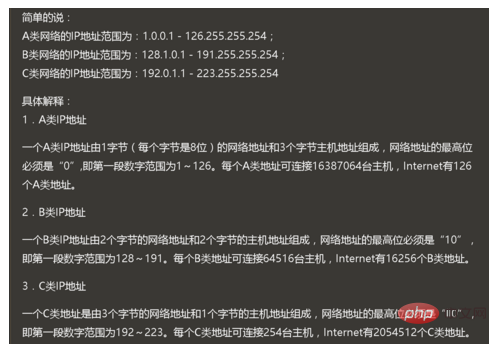

What are the highest three bits of a class c address?
The highest three bits of a class c address are "110".
Related introduction:
A Class C IP address refers to the four segments of the IP address. The first three segments are the network number, and the remaining segment is the local computer number. If the P address is represented in binary, the Class C IP address consists of a 3-byte network address and a 1-byte host address. The highest bit of the network address must be "110". The length of the network identifier in the Class C IP address is 21 bits, the length of the host identification is 8 bits.
Class C IP addresses use the first 24 digits to identify the network number, of which the first three digits are specified as "110", and 8 digits identify the host number. In this way, the first segment of the Class C address has a value of "110000~10111" , after conversion to decimal, it is 192~223. The first segment, the second segment, and the third segment together represent the network number. The last segment identifies the host number on the network. Its address range is "192.0.0.0~223.255 .259.255".
Class C addresses are suitable for small networks such as campus networks and office networks. Each Class C network can have up to 254 computers. This type of address has the largest number of addresses among all address types. However, this type of network allows the least number of computers to be connected. This type of IP address can be assigned to anyone in need. Among them, 192.168.0.0~192.168.255.255 is the private address segment of the enterprise LAN.

The above is the detailed content of What are the top three bits of a Class C address?. For more information, please follow other related articles on the PHP Chinese website!
 How to withdraw money on WeChat without handling fees
How to withdraw money on WeChat without handling fees
 How to set ppt background picture
How to set ppt background picture
 What should I do if IE browser prompts a script error?
What should I do if IE browser prompts a script error?
 What is the main difference between c language and python?
What is the main difference between c language and python?
 Introduction to xmpp protocol
Introduction to xmpp protocol
 Turn off win10 automatic updates
Turn off win10 automatic updates
 Usage of RAC in Oracle
Usage of RAC in Oracle
 The difference between Hongmeng system and Android system
The difference between Hongmeng system and Android system




